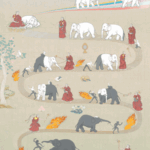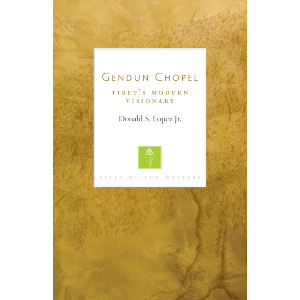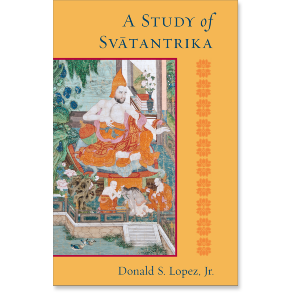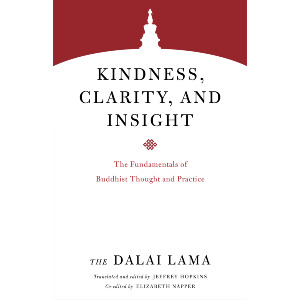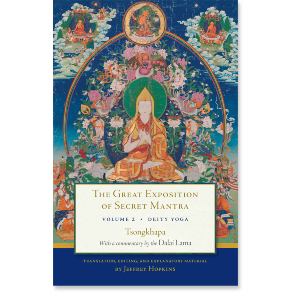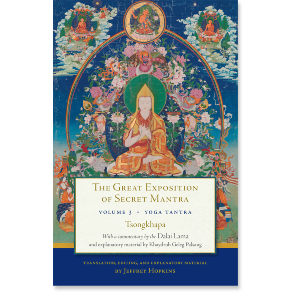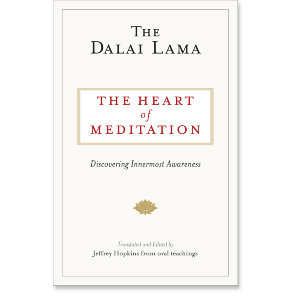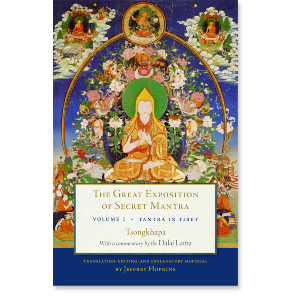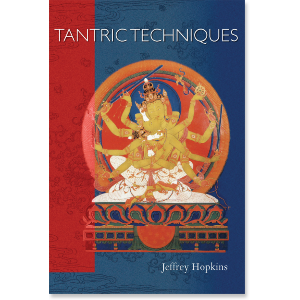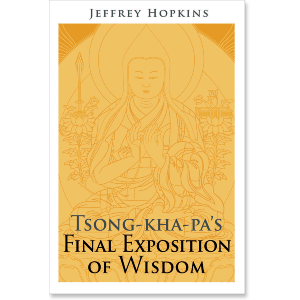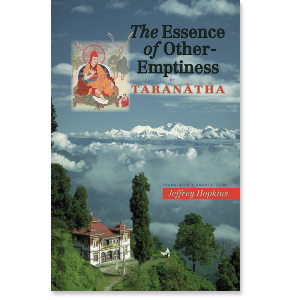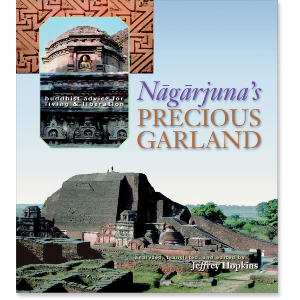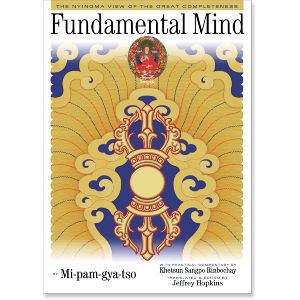| The following article is from the Spring, 1989 issue of the Snow Lion Newsletter and is for historical reference only. You can see this in context of the original newsletter here. |
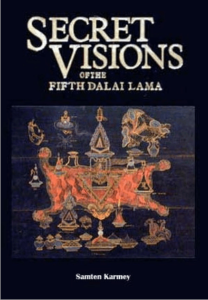
SECRET VISIONS OF THE FIFTH DALAI LAMA
by Samten Darmay
Serindia Publications, London
For centuries Tibet has served the planet as a nation dedicated to spiritual art, literature and practice. In an era when Europe was busy sending its armies around the world to pillage, rape and colonize, Tibet was engaged in studying, cataloging and eulogizing the stages of enlightenment and the varieties of mystical experience. Its GNP was not measured in materialistic terms alone, but in the number of yogis and sages that blossomed forth from within its precincts.
Thus when in 1642 the saintly Fifth Dalai Lama rose to become both spiritual and secular chieftain of the Tibetan nation, echoes of a destiny fulfilled rang throughout the mountains and valleys of Central Asia.
The Fifth Dalai Lama (1617-1682) stands as perhaps the singularly most striking figure in Tibetan history. He was one of those rare men who seem bigger than life itself, a superman who accomplished in one short lifetime the deeds of a thousand ordinary heroes. From the literary viewpoint he was colossal, writing as much as all other Dalai Lamas put together. As a builder he left us with numerous marvels that can compare with the world's greatest architectural achievements, the Potala of Lhasa being perhaps the most well-known of these. His poetry is considered by Asian intellectuals to be among the most inspired verse ever composed in the Tibetan language; and his reputation as a philosopher, historian, artist, doctor and teacher far exceeds that of anyone else of the period. Moreover, he was not some mere artist, intellectual or mystic; his work as a statesman laid the very foundations for the emergence of Classical Tibet, the Tibet that rapidly came to serve as the cultural grandparent to all Central Asia.
Yet he did not accomplish all this without giving rise to some controversy. In the fulfillment of his dreams and ideals, much of the old and stagnant had to be swept aside in order to make way for the new; and although he was a man of great compassion, he was never one to hesitate on the borders of apathetic sentimentalism. His gentleness in no way rendered him indecisive or impotent, and in sculpting his image of a new Tibet he did not fear to strike with the political artist's chisel wherever and whenever it seemed appropriate.
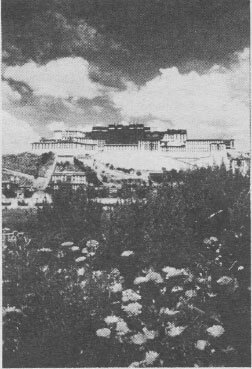
The COLLECTED WORKS of the Fifth Dalai Lama is comprised of twenty-eight bundles of texts, and contains more than a thousand titles. These twenty-eight are divided into three categories Outer, Inner, and Secret with twelve bundles in the first of these categories, eight in the second and eight more in the third. As His Holiness the Dalai Lama points out in his Foreword to the volume under review, traditionally only the first two categories of works were ever printed in Tibet. Generally the texts in the Secret category were only available to high initiates, and were not allowed to be mass-produced or openly marketed; anyone wanting a text in this category would have to request special permission to have a hand-copy made.
Secret Visions of the Fifth Dalai Lama by Samten Karmay is a study of one of these eight Secret Volumes. The Tibetan text of the volume contains sixteen individual titles, the first of these being the Fifth Dalai Lama's catalog of the numerous visions that he experienced during his life.
The edition by Serindia Publications is remarkable in that it is based upon an original and priceless manuscript prepared during the lifetime of the Great Fifth Dalai Lama himself, with hundreds of exquisite color illustrations executed under the Fifth's direct supervision. The Serindia edition, as well as carrying high-quality reproductions of all the illustrations, contains a reducted photographic reprint of the entire Tibetan manuscript. Thus as well as being an excellent work on classical seventeenth century Tibetan art, it is a valuable addition to the library of any Tibetan scholar.
Samten Karmay's contribution is his brief Summary of the contents of the Tibetan texts, and an Introduction that provides the reader with a general picture of Tibetan history and the Fifth Dalai Lama's life.
Although his Summary deals with all sixteen Tibetan texts, the bulk of his commentary focuses on the first of these, Secret Visions itself. The remaining fifteen texts-ritual and liturgical works mainly of an exorcistic nature are given only a paragraph or two each.
A disappointing feature of the Summary is that Mr. Karmay satisfies himself with merely listing the various 'beings' (gurus, buddhas, bodhisattvas, tantric deities, etc.) whom the Fifth saw in his visions, and does not deal with any of the prophetic (and highly poetic) conversations that ensued, nor with the meaning or significance of the visions. By cutting the material to a mere skeleton of events, we are left with something that reads almost like a list or diary of daily appointments. However, it may be argued that for him to attempt to take the material further would have opened a whole other dimension to the work, and would have expanded the volume prohibitively.
Secret Visions of the Fifth Dalai Lama is an elegant and enticing edition. Undoubtedly it is a valuable contribution to our understanding of the complex character of the Fifth Dalai lama, and to the many facets of his personality. It could stand as a landmark work merely on the strength of its artwork, just as it could for the Tibetan texts that it contains, it is the type of publication that does not need to be read to be admired and appreciated; merely holding it and letting one's eyes flow over its pages suffices to bestow upon the beholder the sense of being in the presence of beauty, greatness, the mystical and the very sublime.
-Glenn H. Mullin
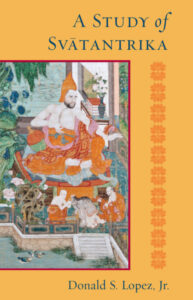
A STUDY OF SVATANTRIKA
by Donald S. Lopez
Snow Lion Publications, Ithaca, NY
In this book, Lopez presents a translation and study which brings to light the seventeenth-eighteenth-century Tibetan Buddhist scholar, Jang-gya's views on the Svatantrika-Madhyamaka school of Indian Mahayana Buddhism. The work translated by Lopez is, in effect, one chapter from the larger work by Jang-gya expounding the views of the various Indian Buddhist and non-Buddhist schools. Jang-gya's interpretations are based primarily on those of the great Gelugpa founder, Tsongkhapa as found in his own compositions and as interpreted by later tradition. In preparing this work, Lopez has consulted with a number of contemporary scholars who provided oral commentary on Jang-gya's composition. Lopez's excellent introduction and commentary set Jang-gya's work within its larger Indian and Tibetan context and place Lopez' own study within the tradition of Western Buddhology. This work has been produced with care and integrity and makes an important contribution to our knowledge of Svatantrika.
Reginald Ray for Religious Studies Review
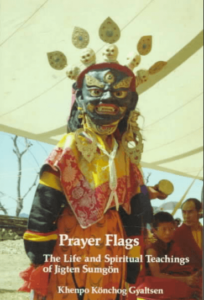
PRAYER FLAGS-THE LIFE AND SPIRITUAL TEACHINGS OF JIGTEN SUMGON
by Khenpo Konchog Gyaltsen
Snow Lion Publications, Ithaca, NY
Jigten Sumgon was the founder of the Drikung Kagyu, a subschool of the Kagyu tradition, one of the four great lineages of Tibetan Buddhism, and which originated in Tibet with Marpa the translator, whose teachers included the great Indian pandit Naropa. Marpa's most illustrious disciple was Jetsun Milarepa, a legend in Tibet. He in turn taught Gampopa who had also imbibed the Kadam tradition from the Indian pandit Atisa. From Gampopa came the four elder lineages of the Kagyu and from one of these the Phagdru Kagyu, founded by Phagmo Drupacame the eight younger lineages (such as the Karma Kagyu, etc.). Of these eight one was the Drikung Kagyu and the subject of this book.
The initiator and translator of this book is the Abbot Konchog Gyaltsen, a scholar and meditator in the Drikung tradition. As well as translating the life of Jigten Sumgon, he has included the biographies of Gampopa and Phagmo drupaJigten Sumgon's main teacher. The second half of the book contains a selection of Jigten Sumgon's Vajra songs and a brief exposition of the Fivefold Profound Path of Mahamudra, the main philosophy and practice of the Kagyu tradition.
Like most Tibetan biographies, this one is replete with miracles and mysterious happenings which accompany the events surrounding the subject's life. During one discourse Jigten Sumgon actually stopped the sun from sinking so that he could finish his teachings. His visions and his ability to communicate with other realms are astonishing. His songs are terse, profound and reverberate with typical Mahamudra themes such as non-duality and non-effort, subjects very open to misinterpretation by the uninitiated. Likewise, the section on Mahamudra philosophy and practice is brief and to the point, going straight to the nature of reality and of the mind. All this is in keeping with the Kagyu emphasis on practice and intense meditation. A three-year uninterrupted meditational retreat is standard practice for a Kagyupa (a devotion which the translator has successfully performed).
The translator states that he has brought this book out for the many Westerners interested in Buddhism, 'to kindle the flame of their understanding'. Followers of the Kagyu tradition will obviously revere this book and others whose dispositions incline them towards the kind of approach Mahamudra offers will likewise be inspired. Presumably the translator chose these texts in order to give his readers a taste of the practice and practitioners of the Drikung Kagyu lineage. They are certainly fascinating enough to inspire the interested reader to search out more information on this noble tradition.Gavin Kilty, Buddhist Studies Review.
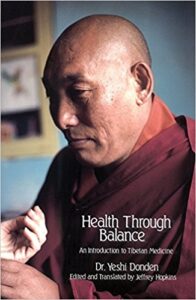
HEALTH THROUGH BALANCE
by Dr. Donden
Snow Lion Publications
Health Through Balance offers a fresh and insightful perspective on American eating habits as seen from the viewpoint of a Tibetan physician. The information on traditional food preparation and storage is immensely valuable. His food categorization is based on the Tibetan four-element system. Dr. Donden presents an expanded view of disease as precipitated primarily from our own behavior. Health Through Balance is a theoretical and inspirational book that offers a grand overview and some practical information.
Journal of Traditional Acupuncture

